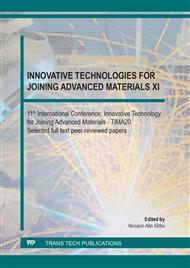[1]
Jindal, S., Chhibber, R., Mehta, N.P.: Issues in welding of HSLA steels. Advanced Materials Research, 365 (2012), pp.44-49.
DOI: 10.4028/www.scientific.net/amr.365.44
Google Scholar
[2]
Ferreira Jorge, J.C., Dias Monteiro, J. L., Carvalho Gomes. A. J., Souza Bott, I, Guimarães de Souza, L.F., Mendes, M.C., Araújo, L.S.: Influence of welding procedure and PWHT on HSLA steel weld metals, Journal of Materials Research and Technology, 8 (1), (2019), pp.561-571.
DOI: 10.1016/j.jmrt.2018.05.007
Google Scholar
[3]
Ampaiboon, A., Lasunon, O-U., Bubphachot, B.: Optimisation and Prediction of Ultimate Tensile Strength in Metal Active Gas Welding, The Scientific World Journal, 2015, http://dx.doi.org/10.1155/2015/831912.
DOI: 10.1155/2015/831912
Google Scholar
[4]
Klarić S., Samardžić I., Kladarić I.: MAG welding process—analysis of welding parameter influence on joint geometry, Proceedings of the 12th International Research/Expert Conference; August 2008; Istanbul, Turkey, p.185.
Google Scholar
[5]
Kim I. S., Son K. J., Yang Y. S., Yaragada P. K. D. V.: Sensitivity analysis for process parameters in GMA welding processes using a factorial design method, International Journal of Machine Tools and Manufacture, 2003, 43(8), pp.763-769,.
DOI: 10.1016/s0890-6955(03)00054-3
Google Scholar
[6]
Benyounis K. Y., Olabi A. G.: Optimization of different welding processes using statistical and numerical approaches - a reference guide, Advances in Engineering Software, 2008, 39(6), pp.483-496,.
DOI: 10.1016/j.advengsoft.2007.03.012
Google Scholar
[7]
Correia D. S., Gonçalves C. V., Junior S. S. C., Ferraresi V. A.: GMAW welding optimization using genetic algorithms, Journal of the Brazilian Society of Mechanical Sciences & Engineering, 2004, 26(1), pp.28-32,.
DOI: 10.1590/s1678-58782004000100005
Google Scholar
[8]
Cool T., Bhadeshia H.K.D.H., MacKay D.J.C.: The yield and ultimate tensile strength of steel welds. Materials Science and Engineering A, 1997, 223(1-2), pp.186-200,.
DOI: 10.1016/s0921-5093(96)10513-x
Google Scholar
[9]
Montgomery D.C.: Design and Analysis of Experiments, New York, USA, John Wiley & Sons, (2001).
Google Scholar
[10]
* * * EN ISO 15614-1:2017: Specification and qualification of welding procedures for metallic materials - Welding procedure test - Part 1: Arc and gas welding of steels and arc welding of nickel and nickel alloys.
DOI: 10.3403/03062226
Google Scholar


